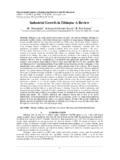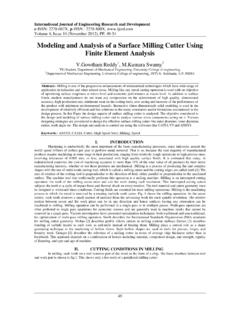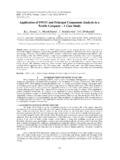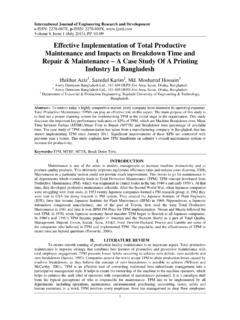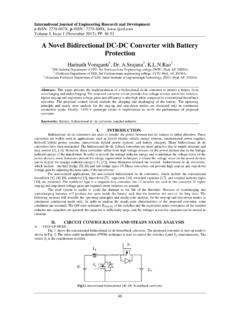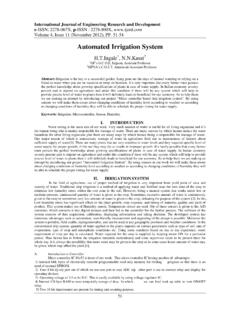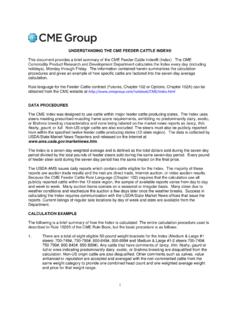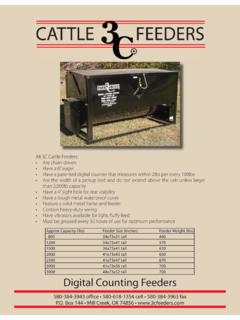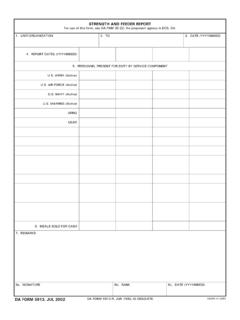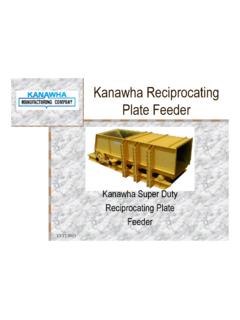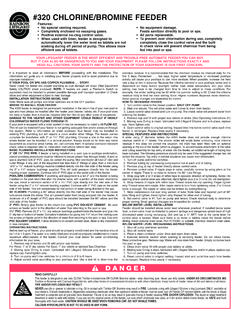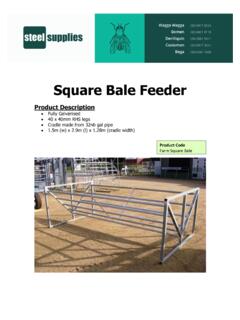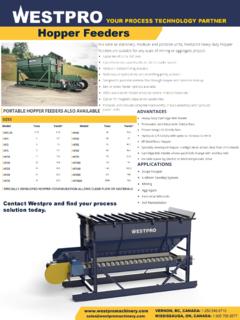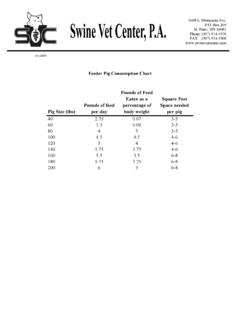Transcription of Solid Modeling and Analysis of Vibrating Grizzly …
1 International Journal of Engineering Research and Development ISSN: 2278-067X, Volume 1, Issue 8 (June 2012), 34 Solid Modeling and Analysis of Vibrating Grizzly feeder (VGF) Bhavsar , and Prof. 1 Mechanical Engineering Department, Birla Vishvakarma Mahavidhyalaya., , Anand. Gujarat, India. 1,2 Department of Mechanical Engineering, Birla Vishvakarma Mahavidhyalaya., , Anand. Gujarat, India. Abstract The project involved in this paper is a Vibrating Grizzly feeder , 1200 TPH capacity designed by ELECON Engineering Pvt. Ltd.
2 The main function of VGF is to convey the material by effect of creation of vibration. So Modal Analysis of VGF should be carried out. In this paper based on structural vibration theory and theory of finite element model(FEM), the 3D model of VGF is made in Pro-E and analyzed on ANSYS-workbench 14. Vibration mode and frequency can be concluded by calculating of the VGF s FEM model. Further different loading conditions were applied on VGF and under this conditions deformation and Von Mises stress has been found out. Keywords: Vibrating Grizzly feeder (VGF), natural frequencies, modes, static structural Analysis , ANSYS-14, 3-D parametric model, PRO-Engineer software.
3 I. INTRODUCTION The feeder is a piece of material handling equipment used to regulate the flow of a bulk material from a bin or hopper. A feeder is essentially a conveyor used for short distances where a constant rate of dispersal is required. There are many types of feeders to suit many different industries; ranging from mining, to pharmaceuticals, to agriculture. Feeders are often used in conjunction with other types of material handling equipment, like conveyors, crushers, dryers, grinders, blenders, and mixers Feeders can be loosely classified as either volumetric or gravimetric: (I) Volumetric feeder : (II) Gravimetric feeder Feeders are further segmented according to their method of conveying: 1.
4 Apron feeder . 2. Belt feeder . 3. Chain feeder . 4. Rotary-Vane feeder . 5. Roller feeder . 6. Revolving disc feeder . 7. Screw feeder . 8. Vibratory feeder 9. Vibrating Grizzly feeder . A. Working principle of Vibrating Grizzly feeder : Here vibration means to move back and forth rapidly. On a vibratory feeder , material is thrown up and forward so that it drops to the surface at a point further down the tray. This is the feeder s amplitude. The number of times per minute that this repeats is the frequency. A third variable is the angle of meaning how high the product is thrown as compared to its horizontal movement.
5 The diagram (above) illustrates the action of a single particle of material moving along the tray s surface. During a Vibrating stroke the tray surface travels between its lowest point A to its highest limit C . On the upward stroke, the particle is in contact with the tray from A to B . At that point the velocity of the particle become greater than the tray and Solid Modeling and Analysis of Vibrating Grizzly feeder (VGF) 35 the particle leaves the surface on a feed flight trajectory from B to D . The particle lands forward on the tray at point D.
6 This completes one cycle. With equipment operating on a 60-cycle power supply, this cycle of material flow is repeated 3600 times per minute. Adjusting or varying the stroke of the tray controls the feed rate. The number of strokes will remain constant to the power supply. However, the stroke length can be varied by changing the voltage input to increase or decrease the feed rate. Each vibratory feeder or conveyor is designed with a different amplitude, frequency and angle of deflection in order to move different materials at specific rates. The equipment s design is based on many factors including the material being processed, flow rate of the process, nature of the environment, need to start and stop (cycle) the process, cost to operate the equipment and likelihood of repairs.
7 Such Vibrating Grizzly feeder work on the phenomena of Vibration, so vibration is too much important in Analysis of feeder . Therefore Natural Frequency of system is very important to study to save structure from resonance. It may destroy in any working condition, it will result in enormous economical losses .Modal parameters are the main parameters for such Vibrating system. Therefore modal Analysis is important for study of dynamic characteristics. Further different loading conditions also checked out. II. LITERATURE REVIEW Earlier work on vibratory bowl feeders was reported by Redford and Boothroyd [1].
8 They presented a theoretical Analysis of vibratory feeding where a phase difference may exist between the parallel and normal components of track motion. Boothroyd et al. [2] studied the automatic feeding and orientation of parts on vibratory bowl feeders and developed various forms of orienting devices to improve feeding efficiency. Reynolds [3] considered the need to evaluate fully the vibratory feeder properties and the parts being conveyed. To develop a reliable mode1 to evaluate feed rates, Lonie [4] developed a simple model based on two masses connected by a spring and a damper and MacDonald and Stone [5] developed a simple linear vibratory feeder model using the MacPascal language.
9 Perform dynamic Analysis of a vibratory feeder [6]. He found that various factor such as deck inclination, amplitude, frequency, coefficient of friction could affect conveying velocity of moving body. He found that velocity of a body is particularly sensitive to coefficient of friction and deck inclination angle. He found that for a particular set of operating condition the vibratory feeder initially conveys body at an increasing velocity with increase in slope, and then after particular angle steady state velocity is achieved which corresponds to constant slope.
10 He also developed the program to find capacity of feeder using Turbo C++. R. T. FOWLER and S. C. LIM[7] found that effectiveness of screen increases with increase in aperture, increase in slope of deck up to 15 and then further reduces, An increase in frequency of vibration to a certain maximum and then a decrease in effectiveness with higher frequencies. III. SELECTION OF AMPLITUDE AND ANGLE OF INCLINATION FOR DRIVE VGF work on the principle of creation of vibration, with Vibrating movement material travels on trough and screen area. This vibration may produce by many way, such as (a) Brute force mechanical drive (b) Eccentric shaft mechanical drive (c) crank drive, we have to work for high capacity up to 1200 TPH, Crank drive is not suitable for such high capacity because rigid connecting rod makes it hard to start the conveying [8], So we have adopted Brute force mechanical drive, which is rotating unbalance mass drive and create vibration with certain amplitude.
